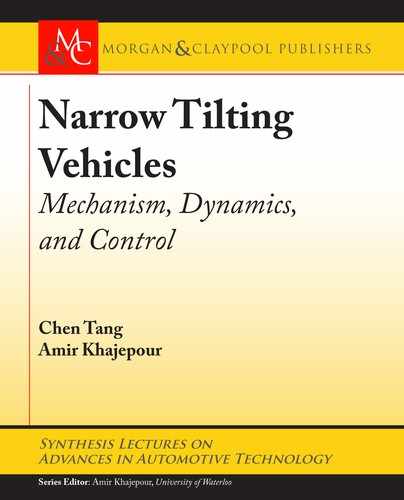
1
C H A P T E R 1
Urban Vehicles and Narrow
Tilting Vehicles
1.1 ISSUES IN URBAN TRANSPORTATION
As the number of vehicles in big cities has dramatically increased in recent years, people have had
to face urban transportation issues like congestion, parking, and pollution. e average number
of occupants per vehicle, as investigated by the U.S. Department of Transportation, is found to
be 1:58 [1]. Conventional four-wheeled vehicles, which are designed to accommodate four to
six passengers comfortably as well as providing sufficient space for their cargo, are considered
unnecessarily large for their average passenger load in normal city driving [2]. e surplus sizing
of the vehicle takes more space when driving on the road as well as parking, and the extra weight
comes along with an inevitable increase in fuel consumption.
On the other hand, two-wheeled transportation tools, such as bicycles, mopeds, and mo-
torcycles, are considered extremely space and fuel efficient [3] for the personal mobility. How-
ever, passenger safety and weather protection designs of such two-wheelers are not as good as
their four-wheeled counterparts. Conventional automobiles also perform significantly better for
their payload-carrying capability as well as the on-board electronics for enhanced active safety.
Apart from that, drivers of two-wheelers also need to learn how to balance the vehicle under
various conditions as it is inherently unstable at low speeds, which also limits its public accep-
tance.
To address the above-mentioned issues in urban transportation systems, concepts of urban
vehicles are proposed [2, 4] for the niche market of personal mobility by combining the benefits
of conventional cars with those of two-wheelers. ey are designed with recent advancements in
automotive mechatronics but in a narrow footprint to seat limited passengers. e reduced size
saves on production cost and utilizes existing road infrastructure (e.g., lane and parking space)
more efficiently. e reduction in the gross mass also helps to improve fuel efficiency and cut
pollution, which gives it a competitive advantage in emerging car-sharing programs.
1.2 NARROW URBAN VEHICLE AS A SOLUTION
e previous section demonstrated the need for compact urban vehicles which carry limited
passengers in pursuit of significantly improved fuel efficiency while not compromising on the
safety and comfort offered by standard four-wheeled cars [3]. Due to the unstable nature of

2 1. URBAN VEHICLES AND NARROW TILTING VEHICLES
two-wheelers, three- and four-wheeled narrow vehicle designs are usually adopted to address
urban transportation challenges. Such vehicles are designed to provide just the right space to
seat one or two people in tandem for a daily commute, and the narrow footprint enables them
to be operated on reduced-size lanes and parked in compact spaces. Benefiting from the enclosed
cabin, a weatherproof interior and a crash-worthy body structure could be designed for a more
comfortable and safer ride. e concept of such narrow urban vehicles is visualized in Figure 1.1.
Figure 1.1: Concepts of narrow urban vehicles on the road. (Image generated using CARLA
simulator [5].)
e design of such vehicle with a small footprint seems to be the cure for many urban
transportation issues, but it has its own problem—such vehicles are less stable against rollover
compared with conventional cars. A good field-of-view for human drivers should be maintained
which means the riding height of a narrow urban vehicle should be similar to a conventional
street car, as illustrated in Figure 1.2. With its track width reduced almost by half, a narrow
vehicle becomes significantly less stable. According to static stability factor (SSF), which was
adopted by the new car assessment program (NCAP) as one of the ratings for vehicle rollover
resistance from 2001–2003 [6], the rollover danger of narrow vehicles almost doubled compared
with regular-width automobiles.
Lateral centrifugal force is the major cause for un-tripped rollovers, and high speeds in
tight cornering could generate risky centrifugal forces to endanger vehicle stability. By consider-
..................Content has been hidden....................
You can't read the all page of ebook, please click here login for view all page.
